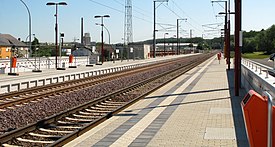Pétange – Luxembourg railway line
| Pétange – Luxembourg | |||||||||||||||||||||||||||||||||||||||||||||||||||||||||||||||||||||
|---|---|---|---|---|---|---|---|---|---|---|---|---|---|---|---|---|---|---|---|---|---|---|---|---|---|---|---|---|---|---|---|---|---|---|---|---|---|---|---|---|---|---|---|---|---|---|---|---|---|---|---|---|---|---|---|---|---|---|---|---|---|---|---|---|---|---|---|---|---|
|
The Niederkerschen-Sassenheim station after the double-track expansion of the line
| |||||||||||||||||||||||||||||||||||||||||||||||||||||||||||||||||||||
| Gauge : | 1435 mm ( standard gauge ) | ||||||||||||||||||||||||||||||||||||||||||||||||||||||||||||||||||||
| Power system : | 25 kV, 50 Hz ~ | ||||||||||||||||||||||||||||||||||||||||||||||||||||||||||||||||||||
| Maximum slope : | 10 ‰ | ||||||||||||||||||||||||||||||||||||||||||||||||||||||||||||||||||||
| Minimum radius : | 250 m | ||||||||||||||||||||||||||||||||||||||||||||||||||||||||||||||||||||
| Top speed: | 140 km / h | ||||||||||||||||||||||||||||||||||||||||||||||||||||||||||||||||||||
|
|||||||||||||||||||||||||||||||||||||||||||||||||||||||||||||||||||||
The Pétange – Luxembourg line is an electrified line in Luxembourg.
history
After the Franco-Prussian War , from 1871 onwards, Luxembourg only had a border with France about 10 km long . All rail transport had to be carried out either via the Belgian Athus or the German Metz. A direct connection from Rodingen to Longwy in France was not established until 1886, but there was still no direct connection with Luxembourg City. In addition to the previously necessary detour via Esch or Kleinbettingen, the different operating conditions - part of the way had to be covered with the anonymous Luxemburgish Prince Heinrich Railway and Ore Mine Company (PH), the other with the Wilhelm-Luxemburg-Gesellschaft (WL) Problem.
Although the Prince Heinrich Railway Company planned a connection from Pétange to Luxembourg in the 1870s, it was intended to touch numerous localities and would only have shortened the route insignificantly. After the financial difficulties of this company in the second half of the 1870s, the already partially licensed direct connection was no longer built. A narrow-gauge railway applied for in 1881 was completely rejected by the government; Luxembourg only wanted to allow a standard-gauge railway. However, the PH was not interested in a direct standard-gauge connection, as this would make the transport route to the German Reich much shorter than on its Pétingen – Ettelbrück (Attert route) line.
Only when the WL planned a direct connection for a concession in 1891 did the PH show interest again. Although the Attert route lost its highly profitable transit traffic, at least some of the traffic remained with the PH.
In 1894 the PH was granted the concession to build and operate the Pétange – Luxembourg line. However, the company took its time with the construction of the railway and the work was repeatedly delayed. Construction began in 1898, and the approximately 20 km long, technically uncomplicated single-track line was not completed until 1890. The official opening of the line took place on September 7, 1900. Since there was still a lot of remaining work to be done, freight traffic could not start until 1901.
The newly built line quickly gained international importance, and the direct connections between Luxembourg and Paris were managed via it. Local passenger traffic also developed better than forecast at the planning stage.
For decades the line was an important part of the Luxembourg rail network. It was not until the international freight and passenger traffic was directed over the electrified Esch – Bettembourg – Luxembourg connection that its importance declined in the 1960s.
In 1980/81 the line was electrified. The line has been double-tracked since November 2012. The timetable could be improved by this expansion, and the top speed was increased to 140 km / h. Since then, the route has been remote-controlled by an ESTW in Pétange. During the expansion, stations were also modernized and level crossings, such as B. in Bascharage, canceled by crossing structures.
traffic
In passenger traffic, the 2014 route will be served as line 70 by regional trains every half hour on weekdays and at least every hour on public holidays. There are also regional express trains, especially during rush hour, which do not stop at all train stations.
literature
- Ed Federmeyer: Railways in Luxembourg. Volume 1, Wolfgang Herdam Fotoverlag, Gernrode 2007, ISBN 978-3-933178-21-3 .
Web links
- www.rail.lu Luxembourg – Pétange line
